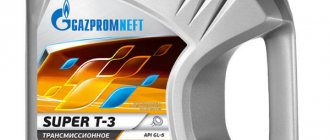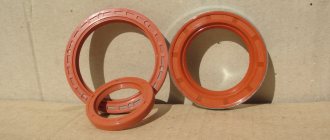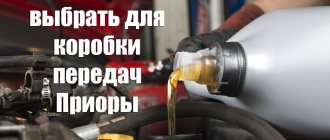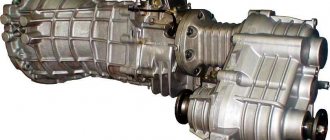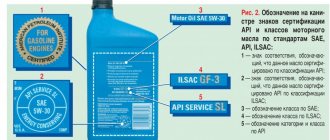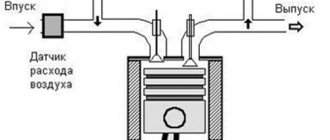Today we’ll talk about the crankcase on Kalina with an 8-valve engine. And to be more precise, about cleaning this system. Crankcase gases straight from the crankcase (hence the name) are sent mixed with air to the intake manifold for re-burning, thus saving a certain percentage of fuel. So, along with the gases, oil particles enter the system and clog it.
It is this oil that needs to be cleaned from the crankcase ventilation system. Over time, plaque forms on the walls of the hoses, which impedes the passage of gases.
In the Kalinovsky engine, in the valve cover, there is a special separator that separates crankcase gases from the oil. It gets clogged the most. So, let's get started. The entire ventilation system consists of 3 pipes. We need to unscrew them.
Then remove the valve cover. There are two bolts on the back side, unscrew them and get to the separator.
The easiest way to clean it from oil and deposits is in a bath of gasoline or solvent.
While the separator is acidifying, you can work on the pipes. In general, if they are heavily soiled, it is advisable to replace them with new ones. In my case, I replaced only one - coming from the valve cover to the air filter pipe. The rest were washed with carburetor cleaning fluid (great stuff, it corrodes absolutely everything). The separator itself can also be washed a second time with this thing.
We wipe everything with a clean cloth and put it back together as it was. Pay attention to the condition of the valve cover gasket. It is considered disposable and it is better to replace it with a new one each time you remove it in order to avoid oil leaks.
Modification of the crankcase ventilation system Kalina 8 valves
This system could be improved a little. One of the 3 pipes supplies crankcase gases directly to the throttle valve assembly next to the IAC. If they contain oil, it will definitely settle there. This is how the IAC becomes clogged. So, to avoid this, you can embed a regular fuel filter right in the middle of this pipe.
It will trap oil particles contained in crankcase gases. After a few hundred kilometers, you will see for yourself. Monitor the condition of this filter and promptly change it to a new one. On average, as practice shows, it needs to be changed every 1000 kilometers.
Video
Tools:
- Open-end wrench 10 mm
- Open-end wrench 13 mm
- Open-end wrench 17 mm
- Medium Phillips screwdriver
Parts and consumables:
- Gasoline/kerosene
- Rags
- Sealant
- Automotive compressor
- Cylinder head cover gasket (if replacement is needed) -2108-1003270-10
Read more: How should the air filter be positioned on a Priora?
Notes:
The crankcase ventilation system of the VAZ Lada Kalina 1118 tends to accumulate tarry deposits from crankcase gases, which make it difficult to remove these gases into the engine cylinders for combustion. Because of this, the gas pressure inside the engine increases and oil leaks through the seals appear. We recommend cleaning the crankcase ventilation system before each oil change.
1. Remove the decorative plastic engine cover.
2. Loosen the clamp and disconnect the hose of the large branch of the crankcase ventilation system from the air supply pipe.
3. Disconnect the second end of the large crankcase ventilation system hose from the fitting on the cylinder head cover and remove the hose.
4. Similarly, remove the hose of the small branch of the crankcase ventilation system by disconnecting it from the fittings of the throttle assembly and the cylinder head cover.
5. Remove the supply hose of the crankcase ventilation system by disconnecting it from the fittings of the cylinder block and the cylinder head cover.
6. Rinse the hoses with gasoline or kerosene, blow with compressed air and dry. Clean the holes in the fittings and pipes for connecting the hoses.
7. Unscrew the two fastening nuts and remove the cylinder head cover.
8. Unscrew the long 1 and short 2 bolts securing the oil separator from the inside of the cylinder head cover and remove the washers.
9. Remove the oil separator housing.
10. Remove the mesh pack from the cylinder head cover.
11. Thoroughly rinse the screens, oil separator housing and cylinder head cover with kerosene.
12. Turn the meshes in the bag so that they are oriented in the same way, and install the bag in the lid so that on one side it rests against the protrusions in the lid, and on the other side you can see the hole for the bolt that secures the oil separator of the VAZ Lada Kalina 1118.
13. Install the oil separator housing and tighten its mounting bolts.
14. Check the condition of the cylinder head cover gasket and replace if necessary.
15. The hoses of the crankcase ventilation system and the cylinder head cover of the VAZ Lada Kalina 1118 are installed in the reverse order of removal.
The article is missing:
- Photo of the instrument
- Photos of parts and consumables
- High-quality photos of repairs
If, while operating a LADA car, you notice that during load (when the air conditioner is running, the heating is on, etc.) in a traffic jam, the engine begins to operate unstably (troits, pulls poorly, etc.), perhaps the reason lies in the ventilation system crankcase The article proposes to solve the problem by installing a PCV valve from a foreign car.
Purpose of the adsorber purge valve
In the Lada Kalina model, as in principle in any other car equipped with distributed fuel injection, an adsorbing system is necessary to localize the resulting gasoline vapors. They accumulate inside the tank after the engine stops, and after a certain time necessary for the transformation of these vapors into a condensation state, they turn back into liquid fuel. The remaining volume of vapor that failed to return to the tank moves to the adsorber, where it is retained by two valves. The first (gravity type) is necessary to prevent fuel spillage when the LADA Kalina body turns over (in an accident, etc.), and with the help of the 2nd, the pressure indicator inside the tank is monitored.
Formation of crankcase gases
During the combustion of working mixtures, exhaust gases accumulate under high pressure in the engine cylinders. Due to pressure, some of the gases seep into the crankcase. There they are mixed with oil vapors and condensate moisture. The resulting gas mixture is called crankcase gases.
As pressure increases, the gas mixture breaks through the following elements:
- oil seals;
- breather;
- oil dipstick output;
- seals.
If a characteristic effect called “oil drives” appears, it means that when gases escape, motor oil is involved. To stop moving oil from the breather of a diesel engine, it is necessary to maintain the pressure inside the engine within acceptable limits by removing crankcase gases through the ventilation system.
Changing the purge valve on Kalina
The replacement procedure itself is not a complex undertaking. To perform this, the owner will need to acquire a regular Phillips screwdriver and know where the valve is located.
Below we provide an algorithm of actions that allows you to quickly and efficiently complete this procedure.
- Disconnect the corresponding terminal from the negative terminal of the battery.
- You will need to disconnect the power connector from the valve itself.
- For ease of access to the unit, we move the suction pipe of the intake system slightly to the side together with the “Max Air Mass Airflow” sensor. For this purpose, use the indicated screwdriver to loosen the clamp of the pipe and perform the action.
- Now we proceed to dismantling the unit. To do this, disconnect a pair of fittings located on the sides of the product. One of the fastening elements is fixed with a latch and to dismantle it, you will need to recess the latch, then lift the antennae and finally tighten the fitting to the side.
- Before installing a new component, we check that the markings on both valves match and make sure that they are identical.
- Installation and fixation of the product is carried out in the reverse order.
The canister purge valve has been replaced.
Oil from gearbox breather on Kalina
December 18, 2011, 13:47 #1
Hyundai Elantra gls 1.6 Nissan Bluebird 1.8 SLX-G
December 18, 2011, 13:59 #2
Most likely the oil is overfilled, it will squeeze out the excess and calm down. And it definitely wouldn’t hurt you to check the level in the gearbox.
December 18, 2011, 14:03 #3
December 18, 2011, 14:04 #4
the hand does not reach the dipstick. Remove the battery?
Hyundai Elantra gls 1.6 Nissan Bluebird 1.8 SLX-G
December 18, 2011, 14:14 #5
Well, of course, you can leave it like that, but I would make sure that the oil there is not at a minimum. Moreover, as far as I know, there is no sensor for insufficient oil level in the gearbox. That is, if oil spills, she won’t yell about it and you won’t guess anything.
Hyundai Elantra gls 1.6 Nissan Bluebird 1.8 SLX-G
December 18, 2011, 14:22 #6
Just damn it, theoretically assume that if the breather died, kerdyk mana, then your oil will pour out and pour out, and as I said above, you won’t know about it, so it’s better to check/check.
December 18, 2011, 14:31 #7
Thank you! Listen, do you happen to know how to mask the standard holes from the emblems on the rear? trunk?
Hyundai Elantra gls 1.6 Nissan Bluebird 1.8 SLX-G
December 18, 2011, 14:39 #8
alex ufa, December 18, 2011, 14:31, #7
Thank you! Listen, do you happen to know how to mask the standard holes from the emblems on the rear? trunk?
No, although I’ve been interested in it for a very long time. Probably fiberglass with epoxy...
If you find out, write back, it’s very interesting.
December 18, 2011, 14:44 #9
alex ufa, December 18, 2011, 14:31, #7
Thank you! Listen, do you happen to know how to mask the standard holes from the emblems on the rear? trunk?
Usually they install plugs. or to the painters.
December 18, 2011, 16:09 #10
people say you can fill it with auto varnish
10 February 2012, 17:20 #11
I encountered the same problem, it squeezes oil out of the breather. I checked the oil level and it was just below minimum.
Who knows what kind of oil is poured at the factory? And is it possible to mix transmission oils?
10 February 2012, 17:40 #12
Krava, February 10, 2012, 17:20, #11
I encountered the same problem, it squeezes oil out of the breather. I checked the oil level and it was just below minimum.
Who knows what kind of oil is poured at the factory? And is it possible to mix transmission oils?
Hu. oh no
Skoda Octavia A7 1.4 TSI DSG
10 February 2012, 17:44 #13
Krava, February 10, 2012, 17:20, #11
I encountered the same problem, it squeezes oil out of the breather. I checked the oil level and it was just below minimum.
Who knows what kind of oil is poured at the factory? And is it possible to mix transmission oils?
10 February 2012, 17:49 #14
Alex777, February 10, 2012, 17:44, #13
This is how it squeezes out the foam with air bubbles. Now I was googling and found it on one forum. It turns out I'm not the only one.
Source
Let's sum it up
The work of replacing the valve is simple, however, when the owner of a Lada Kalina is not confident in his capabilities or does not show the desire to carry out repair operations in such a high-risk unit as the fuel supply system, we recommend using the services of a specialized workshop.
EGR valve: what is it
The car's EGR Exhaust Gas Recirculation system is a very vague and rather capricious thing, especially with the very low quality of fuel that is found in our area, quite often. The ambiguity of this system lies in the fact that its purpose is purely environmental. waste recycling system
gases or USR, is designed to reduce the amount of nitrogen oxides in the car exhaust. What is the USR, why is it needed and how its malfunctions are expressed, we will talk about all this for now.
What is the EGR valve for?
We should start with the fact that the USR system is installed on most diesel engines and gasoline, naturally aspirated units. The essence of this system is that at certain moments the valve
EGR and a portion of
exhaust gases
.
Schematic representation of the operation of the USR system.
Thus, the amount of oxygen in the fuel mixture is reduced, which in turn reduces its combustion temperature. And at a lower combustion temperature, the amount of nitrogen oxides in car exhaust decreases quite significantly. If the engine is turbocharged, then the range of application of the USR is significantly narrowed, which makes its installation irrational. In such cases, other solutions are used to reduce the amount of harmful components of automobile exhaust.
Exhaust Gas Recirculation does not work at idle speed, it is not used when the engine is cold, and the EGR valve closes when the throttle valve is wide open.
Description of the design of the VAZ 2110 engine ventilation system
The breather with a fixed end of the pipe is located in the lower part of the cylinder block. The opposite end of the pipe connects to the oil separator located in the cylinder head cover. On the opposite side of the head, a special tube is connected to the fitting. This tube is connected to the air inlet pipe.
The operation of the system consists of the following stages:
- The passage of gases into the cavity of the head cover through the diesel breather.
- Separating the oil in the oil separator and supplying it to the valves.
- Mixing and supplying gases to the manifold through the air pipe.
The power unit of this car model is not equipped with a valve that regulates exhaust gas pressure.
In other cars, oil separators may be located in the area of the breather, behind which the pressure valve is located.
USR system management
recirculation system is controlled by the electronic engine control unit. And the command to open or close the EGR valve can be given based on:
- coolant temperature sensor;
- crankshaft sensor;
- throttle position sensor;
Read
In various car models, either all of the listed sensors are used to control the USR valve, or some of them, and in some cases, only the coolant temperature sensor.
What does the EGR valve look like on a Chevrolet Lacetti?
One way or another, the operation of the USR valve is always controlled by automotive electronics. And while this system functions normally, the driver practically does not feel its operation at all. The useful work of the USR system outside of environmental issues is very unnoticeable. This system allows you to save about three percent of fuel on gasoline engines. Also, in some cases, the USR system prevents fuel detonation in the engine. But this phenomenon in itself is rare and extraordinary. As for diesel units, if they have a properly functioning EGR system, they operate more smoothly, softly, and quietly. In addition, in diesel engines, the formation of soot is reduced through the USR. That's all the bonuses that the exhaust gas recirculation system provides the owner.
What is an EGR valve and what is an exhaust gas recirculation system for?
REAL TAXI DRIVER A huge flaw in the design.
EGR (Exhaust Gas Recirculation) System - Evil or Good?
In this video I explained in Russian why the EGR valve is needed
, but to jam it or not, draw your own conclusions.
EGR system malfunctions
Diagnosing problems with the described system is not as simple a task as it might seem at first glance. The trouble is that there are no pronounced symptoms characteristic of EGR problems. The engine seems to be running rough, it seems to be malfunctioning, but it doesn’t seem to be. And only a professional can suspect the exhaust gas recirculation of such unstable engine operation. But before that, various sensors, components and systems of the car are checked. Actually, what problems may arise here:
- deposits of soot and other elements on the parts of the EGR valve, leading to it jamming in any position;
- burnout of the EGR valve;
- clogging of the USR line itself;
- violation of electronic control systems for the USR valve;
If a valve or line is simply clogged, cleaning them, in general, is not difficult, although in some cases such cleaning is simply impossible. Well, if the valve burns out, then you will have to change it, and this, as already mentioned, is by no means cheap.
There are virtually no symptoms specific to problems with the EGR valve. This is, for example, unstable engine operation at idle speed, unmotivated dips in power, lack of pronounced acceleration when the throttle valve is fully opened, and other signs of disturbances in engine operation.
One way or another, do not rush to change the EGR valve or turn it off if there is no obvious damage to the valve and its parts. Perhaps the problem here is not entirely in the USR, because this system is closely interconnected with other components and systems for regulating air supply and exhaust gas removal.
Valve check
Not everyone knows how to distinguish a burnt valve from stuck rings. Actually, it's all quite simple. To check, unscrew the spark plug from the suspect (low compression) cylinder. And check it out:
- If the rings are stuck or the piston is damaged, the spark plug will be thickly coated with oil. After all, the lubricant easily penetrates the cylinder;
- If the valve is burnt out, the spark plug will be in good condition, with virtually no changes.
This is how you can clarify the cause of oil leakage without disassembling the engine. This method gives a high level of accuracy.
- “Symptoms and signs of a burnt valve”;
- “What to do if rings are stuck in the engine.”
Conclusion
. As a rule, problems with oil release through the breather do not begin immediately. Gradually this problem begins to grow. As a result, the engine can throw out up to a liter of lubricant in a short period of time. That’s when drivers wonder why it drives and squeezes oil out of the breather. This really scares people, and the problem is aggravated by the lack of experienced diagnosticians in the services. Often, after “diagnosis”, car enthusiasts overhaul the power unit, although it was enough to reduce the lubricant level or clean the breather.



